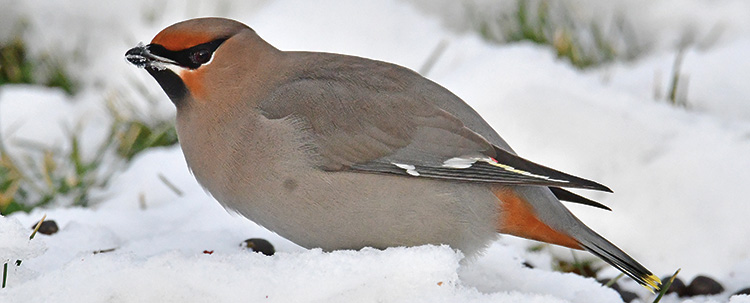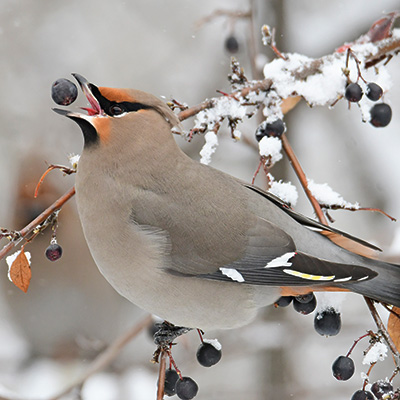Bohemian Waxwings

BY MYRNA PEARMAN
It is always a treat when a winter flock of Bohemian Waxwings suddenly descends on the cotoneaster bushes in our yard. No matter the weather, their constant trilling fills the air and they devour the berries with great flourish. Although always in constant motion, they usually allow close approach – a photographer’s delight!
Like their namesakes, the gypsies of ancient Bohemia, Bohemian Waxwings are consummate nomads. They move south from their mountain/boreal nesting grounds for the winter, wandering great distances in a ceaseless quest for food. Described as being “notoriously” irruptive, the composition of their winter flocks is fluid and the birds regularly move long distances. However, banding studies conducted by Dr. Stuart and Mary Houston in Saskatoon, Saskatchewan, found that many individuals may remain in one area for extended periods of time.
Bohemians and their smaller, more svelte summer cousins, Cedar Waxwings, typically flock independently, but individuals of one species sometimes associate with flocks of the other. Many birders in Alberta carefully scan winter flocks of Bohemians to see if they can find any Cedars among them.
Waxwings are unusual among passerines in that they do not have a true song. However, they do issue a readily identifiable high-pitched, rapid, vibrato trill while perched or in flight. This trill (called the basic trill) has seven variations: social call, contact call, male and female courtship calls, injury call, begging call and disturbance call.
Bohemian Waxwings eat mostly sugary fruits but will supplement their diet with such protein-rich foods as insects, tree buds and the berries of American elm. Their preferred winter fruits, which they pluck and eat either in pieces or swallow whole (sometimes after a ceremonial flip in the air), include juniper, mountain ash, hawthorn, rose hips, cranberry, highbush cranberry, ornamental crabapples and hedge cotoneaster. They will often drink water or eat snow after consuming dried berries. In the spring, they will feed on maple or birch sap drips and will also dine on catkins and tree/shrub blossoms.
It is well documented that Bohemian Waxwings can become intoxicated after consuming fermented berries, especially in late winter or early spring. While the birds have relatively large livers and can metabolize ethanol better than most bird species as they have high levels of alcohol dehydrogenase, they are sometimes seen staggering or fluttering about in a drunken state.
Since they are so abundant, and in winter can be quite docile, Bohemian Waxwings are often targeted by birds of prey, especially Merlins. It is thought that Merlins have increased in number and range because of this abundant prey base, which in turn has thrived because of the widespread planting of ornamental shrubs (especially crab apple and mountain ash) in urban and suburban backyards in the 1970s.
Sadly, Bohemian Waxwings are susceptible to collisions with windows, probably because ornamental fruit shrubs and trees are often planted near buildings. According to Medicine River Wildlife Centre, window collisions are highest in spring, apparently because window reflection patterns are affected by the angle of the sun.
While Bohemian Waxwings are not considered to be a common or typical backyard feeder species, some bird enthusiasts collect, freeze and then set out mountain ash berries and/or crabapples for them. They have also been observed bathing in open water or heated bird baths.
When I first met Charlie and Winnie Ellis, they shared stories about the great flocks of Bohemian Waxwings that visited their yard each winter. In addition to feeding on the many crabapple trees in Winnie’s orchard, the waxwings would receive extra-special treats: Charlie would go to town each week and buy cases of apples and large bags of raisins, which Winnie would mash up together and glob onto pie plates. Charlie would carry the plates outside to the waiting hordes. Luckily, one image remains of Charlie and their Bohemian friends.
References
Fisher C. and J. Acorn. 1998. Birds of Alberta. Lone Pine Publishing, Edmonton.
Pearman, M. 2015. Backyard Bird Feeding: An Alberta Guide. Ellis Bird Farm, Lacombe.
Semenchuk, G. The Atlas of Breeding Birds in Alberta: A Second Look. 2007. Federation of Alberta Naturalists (now Nature Alberta), Edmonton.
Witmer, M. C. (2002). Bohemian Waxwing (Bombycilla garrulus), version 2.0. In the Birds of North America (A. F. Poole and F. B. Gill, Editors). Cornell Lab of Ornithology, Ithaca, NY, USA. https://doi.org/10.2173/bna.714
Myrna is a well-known author, photographer, biologist and naturalist. She is the Biologist and Site Services Manager at Ellis Bird Farm (ellisbirdfarm.ca). You can reach her at mpearman@ellisbirdfarm.ca.
This article originally ran in Nature Alberta Magazine - Winter 2020, Volume 49 | Number 4
